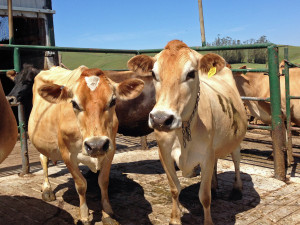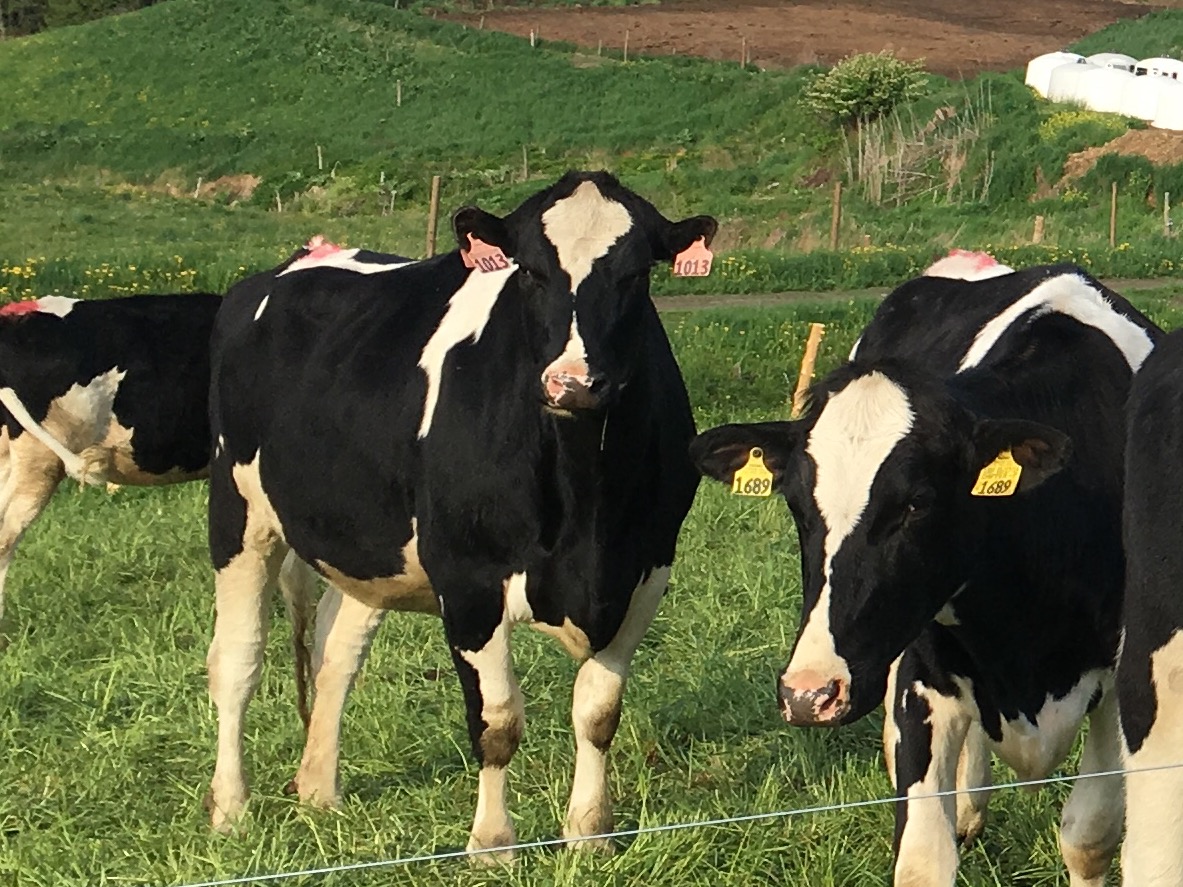By Amy Myrdal Miller, MS, RDN, FAND
National Dairy Council Ambassador
AUTHOR’S NOTE: This article is the second is a series about my visit to Jasper Hill Farm in late May 2016 as part of a “Food Writing from the Farm” course I took at Sterling College. You can access the first article here.
“Our cows are fed dry hay, not fermented hay,” said our tour guide at The Cellars at Jasper Hill Farm in Greensboro, Vermont. “It’s not easy getting enough dry hay for our herd given our short growing season with frequent rain. The hay needs four days to dry, and going four days without rain is unusual here in the summer,” she continued. “The dry hay is so much better for the cows and the cheese.”
I was intrigued but also suspicious and a bit cynical. What’s the difference? Our guide had made a number of claims I was doubtful of during our tour of their multi-million-dollar cheese aging facility. Was this cheese marketing hype or scientific fact?
As I thought more about her claims, I began to wonder if the form of feed (such as hay) matters to the health of the cow, the quality of her milk, the environmental impact of the herd, or the flavor profile and quality of the cheese.
Cutting the Curd, a Heritage Radio Network show hosted by Greg Blais, featured Jasper Hill Farm co-founder Mateo Kehler on November 9, 2015. Listening to that interview I learned that Jasper Hill Farm cows’ diets change as the seasons change, and that the microbes in dry hay can differ from the microbes in other forms of feed (such as fermented hay), which affects the final microbial content and quality of the cheese.
“Dry hay is good feed for cheese making,” according to Kehler. “[During the winter] we have a herd of hand-fed cows at Jasper Hill.” He went on to explain that in addition to dry hay their cows are also fed supplemental grain, which is needed to help metabolize the protein in the feed and turn it into milk proteins. In the spring, summer, and early fall, the cows graze on grass and other forages in pastures on their farm.
“Making cheese on pasture is complicated. You have to be a better cheesemaker to make cheese on grass. The forage changes throughout the season. And your raw material for cheese making, the milk, changes every day.” Pasture grazing can be more efficient and economical. “You’re sending the cows out to feed themselves.” I could sense the smile on Kehler’s face as he said this.
Kehler went on to talk about the challenges of using fermented hay. “It contains microbes that can cause all kinds of mayhem,” he explains. One especially troublesome microbe [for cheese making] is Clostridium tyrobutyricum, bacteria that grow under anaerobic conditions in the moist, fermenting hay. The spores can survive pasteurization, ferment in the cheese, and produce hydrogen sulfide gas, which according to Kehler, “smells like farts, unpleasant aromas you don’t want in your cheese.” The cheese will also blow up, creating not only undesired aromas but also splits and cracks that both cheese mongers and consumers find unsettling.
So, okay, the type of hay really matters for the final quality of the cheese. But what about the environmental impact of various feed choices for dairy cows? What impact does the feed have on methane production?
Methane is a greenhouse gas with 25 times the global warming potential of carbon dioxide. If we want to reduce greenhouse gas emissions in this country, shouldn’t we care about the quality of the feed fed to ruminant livestock like dairy cows? I was able to learn a lot about this issue while attending the 2016 Dairy Industry Sustainability Summit in Chicago in May of 2016.
According to Juan Tricarico, Ph.D., Vice President of Sustainability Research at the Innovation Center for U.S. Dairy, methane is a product of microbial fermentation in the rumen. Dairy cows release 95% of the methane the bacteria in their rumen produce through eructation, or belching. “People think cows fart, but they mostly belch out the methane,” explained Dr. Tricarico.
He went on to explain research being done to assess the impact of feed quality on methane production. How can we mitigate greenhouse gas production by changing the quality of the feed? But this is just one of eight research focus areas we’re looking at in Cow of the Future®.” Obviously these issues are much more complex than most of us outside of the dairy community realize.
“In terms of feed management, we’re looking at three areas: ration formulation and feeding, forage management, and concentrate management. We know that just like humans, not all dairy cattle are the same. And we know that diet formulations affect methane emissions directly.”
During a phone interview with Dr. Tricarico I asked for more detail. He explained that the diets for dairy cows are balanced to ensure they get optimal amounts of protein, fiber, carbohydrates, and fat. “On average, dairy cows in the U.S. get 53% of their diet from forages and 47% from concentrate,” says Dr. Tricarico. I don’t know the percentages for Jasper Hill, but I suspect their ratio of forage is much higher most of the year.
So what type of diet is best for reducing methane production in dairy cows? “There is no perfect diet. Everything is a trade off,” says Dr. Tricarico. “We do know that the more concentrates (i.e., corn or soy) you feed, the less methane the cow produces. But cows need forage or fiber to ensure rumen function just like people need fiber for digestive health. You can’t feed just concentrates or the cow will get sick. This is why farmers work with dairy nutritionists to help ensure dairy cow health, wellbeing, and milk yield through proper nutrition.”
He went on to explain the differences in milk production for dairy cows that graze on grass versus cows fed a mixed and carefully balanced diet of forage plus concentrates.
In the U.S. grazing dairy cows can theoretically produce between 23 and 27 kilograms of milk per day with no additional feed, while dairy cows fed a mixed balanced diet can produce between 38 and 42 kilograms per day.
“Grass is 80% water. A cow simply can’t consume enough grass to get enough calories to maximize milk production. Her milk production is compromised by a lack of energy,” he explained. “It’s like asking an Olympic athlete like Michael Phelps to perform well by only eating lettuce. It’s just not possible.”
 One concern I’ve heard from many people is that dairy cows and beef cattle eat feed that could be food for humans. I asked him about this issue.
One concern I’ve heard from many people is that dairy cows and beef cattle eat feed that could be food for humans. I asked him about this issue.
“Dairy cows are amazing contributors to our food supply. They can convert forages from pasture and inedible agricultural and industry by-products into nutrient-rich milk and other dairy products. Our research shows that 20% of what dairy cows eat in this country could be eaten by humans, but only 2.2% actually would be eaten,” he explained.
| Inedible Agricultural and Industry By-Products Eaten by Dairy Cows | |
| · Distiller’s Grains | · Molasses |
| · Corn Gluten Feed | · Cotton gin trash |
| · Cottonseed | · Soy hulls |
| · Soybean meal | · Citrus pulp |
| · Canola meal | · Hominy |
| · Wheat straw | · Wheat |
| · Almond hulls | · Beet pulp |
Source: Innovation Center for U.S. Dairy
I also asked about fermented feed like fermented hay or corn silage. “Those are storage forms of feed that make feeding dairy cows in all 50 states possible regardless of weather. Fermented feed allows those farms to meet the cows’ nutrient needs throughout the year,” Dr. Tricarico explains.
So what is the best diet for dairy cows? “It depends,” says Dr. Tricarico. “The best answer typically comes from the farmer and their cow nutritionist considering their location, available feed, as well as many other factors, like cow breed, herd size, and how the milk will be used (milk, cheese, yogurt, etc.).”
So just like with so many other issues in our food system today, the question about the best diet for dairy cows is complex. Pasture grazing can be efficient and inexpensive component of a balanced diet but is not a year-round option in many parts of the U.S. Pasture grazing also limits milk production due to a limited supply of nutrients.
Fermented feed can cause microbiological challenges for cheese makers, but it provides a wonderful option as a year-round supply of feed for many dairies. And overall, the diets of dairy cows don’t compete with humans.
I’m glad that tour guide at Jasper Hill sparked my interest in this issue, and I’m glad Dr. Tricarico was able to spend some time with me explaining modern dairy farming and the research behind it. “Right now one of our goals is to reconnect the public with dairy farming. Through our efforts we’re trying to support healthy people, communities, economies, and ecosystems.”
About the Author
Amy Myrdal Miller is a farmer’s daughter and dairy farmer’s granddaughter from North Dakota. A registered dietitian nutritionist, Amy runs Farmer’s Daughter Consulting, Inc., a privately held consulting firm that works with food companies, commodity boards, seed companies, and restaurants. In addition to her client work, Amy also serves as a National Dairy Council Ambassador who works to educate the public about issues related to dairy farming and dairy foods as part of healthful dietary patterns. She and her husband Scott Miller live in Carmichael, California where, if allowed by her neighborhood’s CC&Rs, she would keep a couple of Jersey cows in her backyard.

